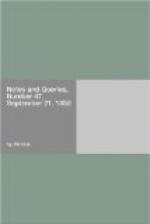* * * * *
HUGH HOLLAND AND HIS WORKS.
The name of Hugh Holland has been handed down to posterity in connexion with that of our immortal bard; but few know anything of him beyond his commendatory verses prefixed to the first folio of Shakspeare.
He was born at Denbigh in 1558, and educated at Westminster School while Camden taught there. In 1582 he matriculated at Baliol College, Oxford; and about 1590 he succeeded to a Fellowship at Trinity College, Cambridge. Thence he travelled into Italy, and at Rome was guilty of several indiscretions by the freedom of his conversations. He next went to Jerusalem to pay his devotions at the Holy Sepulchre, and on his return touched at Constantinople, where he received a reprimand from the English ambassador for the former freedom of his tongue. At his return to England, he retired to Oxford, and, according to Wood, spent some years there for the sake of the public library. He died in July, 1633, and was buried in Westminster Abbey, “in the south crosse aisle, neere the dore of St. Benet’s Chapell,” but no inscription now remains to record the event.
Whalley, in Gifford’s Jonson (1. cccxiv.), says, speaking of Hugh Holland—
“He wrote several things,
amongst which is the life of Camden;
but none of them, I believe,
have been ever published.”
Holland published two works, the titles of which are as follows, and perhaps others which I am not aware of:—
1. “Monumenta Sepulchralia Sancti Pauli. Lond. 1613. 4to.”
2. “A Cypres Garland for the Sacred Forehead of our late Soveraigne King James. Lond. 1625. 4to.”
The first is a catalogue of the monuments, inscriptions, and epitaphs in the Cathedral Church of St. Paul, which Nicolson calls “a mean and dull performance.” It was, at any rate, very popular, being printed again in the years 1616, 1618, and 1633.
The second is a poetical tract of twelve leaves, of the greatest possible rarity.
Holland also printed commendatory verses before a curious musical work, entitled Parthenia, or the Maydenhead of the First Musick for the Virginalls, 1611; and a copy of Latin verses before Dr. Alexander’s Roxana, 1632.
In one of the Lansdowne MSS. are preserved the following verses written upon the death of Prince Henry, by “Hugh Hollande, fellow of Trinity College, Cambridge:”—
“Loe, where he shineth yonder
A fixed Star in heaven,
Whose motion here came under
None of the planets seven.
If that the Moone should tender
The Sun her love, and marry,
They both could not engender
So sweet a star as HARRY.”
Our author was evidently a man of some poetical fancy, and if not worthy to be classed “among the chief of English poets,” he is at least entitled to a niche in the temple of fame.
My object in calling attention to this long forgotten author is, to gain some information respecting his manuscript works. According to Wood, they consist of—1. Verses in Description of the chief Cities of Europe; 2. Chronicle of Queen Elizabeth’s reign; 3. Life of William Camden.




